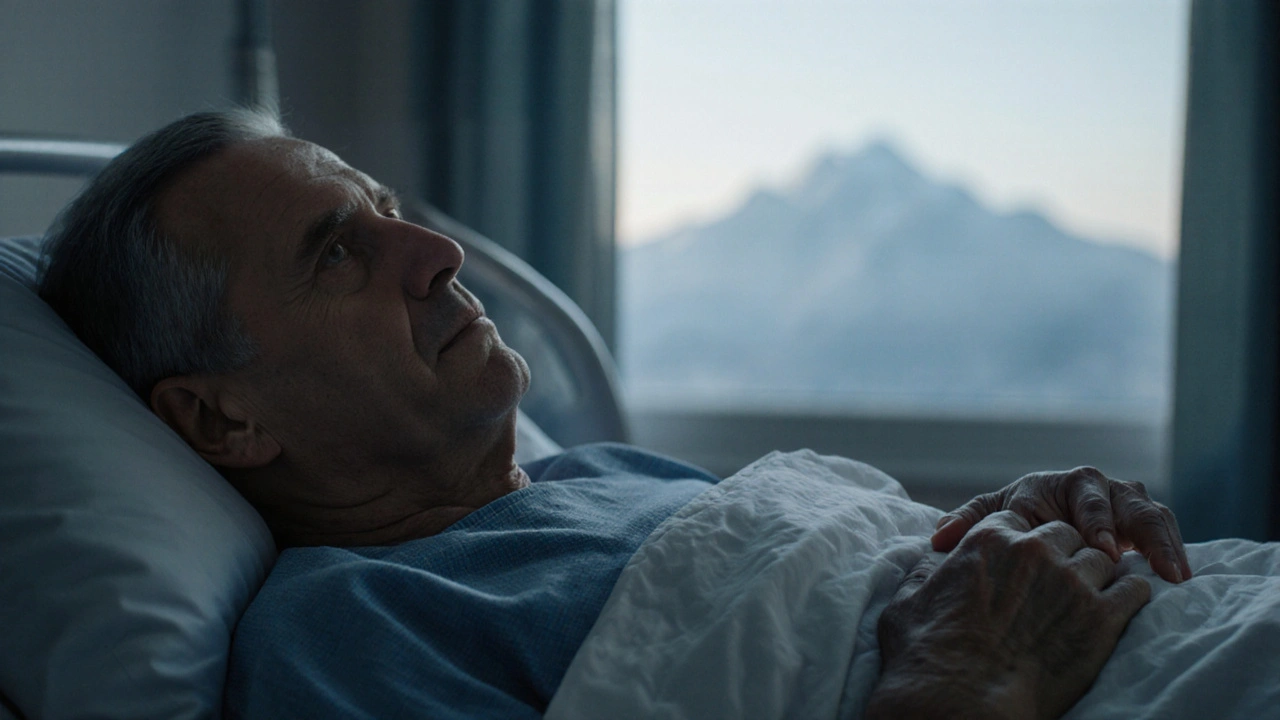Fatigue Level Tracker for Leukemia Patients
Assess Your Current Fatigue Level
Rate your fatigue level today on a scale of 1 to 10 (1 = no fatigue, 10 = extreme fatigue).
Your Fatigue Patterns
Track your fatigue over time to identify patterns and triggers.
Record your fatigue rating, trigger, and notes each day.
Fatigue Assessment
Recommendations:
- Consider scheduling rest periods around your energy peaks.
- Review your sleep hygiene practices.
- Ensure adequate protein intake throughout the day.
Facing leukemia treatment is tough, and one of the most draining side effects is Fatigue a persistent feeling of tiredness that isn’t relieved by rest. It can make simple tasks feel like climbing a mountain and sap the motivation you need for daily life. Below you’ll find practical ways to keep fatigue from taking over, so you can stay active, maintain your mood, and get the most out of your treatment plan.
Key Takeaways
- Identify the main drivers of fatigue-anemia, treatment side‑effects, sleep disruption, and nutrition gaps.
- Use a three‑pillar approach: improve sleep hygiene, boost nutrient intake, and incorporate gentle movement.
- Track energy patterns in a simple diary to spot trends and adjust activities.
- Know when fatigue signals a medical issue that needs professional attention.
- Lean on support groups and caregivers for emotional and practical help.
Understanding Fatigue in Leukemia Treatment
First, let’s break down what’s happening inside the body. Leukemia a cancer of the blood‑forming tissues that disrupts normal blood cell production itself can cause fatigue by crowding out healthy red blood cells. On top of that, the main treatment modalities-Chemotherapy the use of drugs to kill rapidly dividing cancer cells and Radiation therapy high‑energy beams that target cancerous tissue-often produce a wave of nausea, sleep disturbances, and energy loss.
One of the most common biochemical culprits is Anemia a deficiency of red blood cells that reduces oxygen delivery to tissues. When oxygen levels dip, the body simply doesn’t have the fuel it needs to stay alert. In many leukemia patients, anemia can drop hemoglobin below 10g/dL, directly translating to a “heavy‑legged” feeling even after a full night’s sleep.

Common Triggers and How to Spot Them
Beyond anemia, a handful of everyday habits can amplify fatigue:
- Sleep hygiene practices that promote restful, uninterrupted sleep-late‑night screen time, irregular bedtimes, or a bedroom that’s too warm can all erode sleep quality.
- Nutrition the intake of calories, protein, vitamins, and minerals needed for energy production-skipping meals or relying on low‑nutrient snacks leaves the body under‑fuelled.
- Physical activity any movement that raises heart rate, from walking to light resistance work-while too much can backfire, a complete lack of movement can make muscles weak and worsen fatigue.
- Medication side effects-certain anti‑nausea drugs, steroids, or antihistamines can cause drowsiness.
Keeping a simple diary that notes when you feel most tired, what you ate, and how much you moved can reveal patterns. For example, you might notice a dip in energy right after a chemotherapy infusion, or a sharp drop on days when you ate a low‑protein breakfast.
Practical Strategies to Manage Fatigue
1. Prioritize Quality Sleep
Start by creating a bedtime routine that signals the brain it’s time to wind down. Turn off screens at least an hour before bed, keep the room temperature around 18-20°C, and consider a white‑noise machine if hospital sounds creep in. If you find yourself waking frequently, a short 20‑minute power nap in the early afternoon can restore alertness without disrupting nighttime sleep.
2. Eat for Steady Energy
Spread protein throughout the day-think Greek yogurt, eggs, lean poultry, or legumes-because protein helps repair blood cells and stabilizes blood sugar. Add complex carbs like whole‑grain oats or quinoa for a slow release of energy, and include healthy fats (avocado, nuts) to keep calories dense. Small, frequent meals are easier on the stomach, especially when nausea is present.
3. Move Gently but Consistently
Even a 10‑minute stroll around the ward or a seated stretch routine can lift mood‑boosting endorphins and improve circulation. Aim for low‑impact activities such as yoga, tai chi, or light resistance bands. The key is consistency-schedule movement at the same time each day so it becomes a habit, not a chore.
4. Schedule Your Day Around Energy Peaks
Most patients report a “peak” of energy mid‑morning, about two to three hours after waking, and another small bump after lunch. Use these windows for tasks that require focus, like paperwork, phone calls, or physical therapy. Reserve the low‑energy periods for passive activities-reading, listening to podcasts, or simply resting.
5. Review Medications with Your Oncology Team
Ask your doctor whether any prescribed drugs might be exacerbating fatigue. Sometimes a dose adjustment, a switch to a non‑sedating anti‑nausea agent, or a brief “drug holiday” can make a noticeable difference. Never change your regimen on your own-always coordinate with the care team.
6. Manage Stress and Mood
Emotional strain can amplify physical tiredness. Techniques like guided breathing, mindfulness meditation, or journaling can lower cortisol levels, which in turn reduces the perception of fatigue. If you feel persistent low mood, consider speaking with a mental‑health specialist-depression is a treatable cause of fatigue.
7. Lean on Support Networks
Connecting with others who understand what you’re going through can lift spirits and provide practical tips. Local Support groups organized meetings where patients and families share experiences and coping strategies-whether in‑person at Adelaide’s Cancer Centre or online forums-offer a sense of community. Even a brief phone call with a friend can interrupt the fatigue cycle.
When Fatigue Signals a Medical Issue
Not all tiredness is harmless. Seek immediate medical advice if you notice any of the following:
- Sudden, severe weakness accompanied by dizziness or shortness of breath.
- Hemoglobin levels falling below 8g/dL, which often requires a blood transfusion.
- Fever, chills, or unexplained weight loss-possible signs of infection or disease progression.
- Persistent low mood, loss of interest, or thoughts of hopelessness, which may indicate depression.
Prompt evaluation can lead to interventions like iron supplements, erythropoietin‑stimulating agents, or medication adjustments that dramatically improve energy levels.

Comparison of Common Fatigue Drivers and Management Tips
| Cause | Typical Onset | Top Management Strategies |
|---|---|---|
| Anemia | Within weeks of diagnosis or after intensive chemo | Blood work monitoring, iron/folate supplementation, possible transfusion |
| Chemotherapy side‑effects | During infusion cycles | Adjust dosing schedule, anti‑nausea meds, scheduled rest periods |
| Poor Sleep hygiene | Ongoing | Consistent bedtime, dark/quiet room, limiting caffeine after noon |
| Inadequate Nutrition | Often after nausea episodes | Small, protein‑rich meals, oral nutrition supplements, dietitian referral |
| Lack of Physical activity | Gradual increase over treatment course | Gentle walks, seated exercises, physiotherapy guidance |
Next Steps and Troubleshooting
If you’ve tried the tips above and fatigue remains a barrier, consider the following troubleshooting flow:
- Re‑evaluate blood work: check hemoglobin, iron, B12, and thyroid levels.
- Discuss medication timing with your oncologist-sometimes moving a sedating drug to bedtime helps.
- Schedule a brief consult with a clinical nutritionist to fine‑tune calorie and protein targets.
- Join a local Support group for peer‑shared energy‑management hacks.
- If mood symptoms dominate, request a referral to a psycho‑oncology specialist.
Remember, coping with fatigue is a marathon, not a sprint. Small, consistent tweaks often add up to a noticeable lift in daily stamina.
Frequently Asked Questions
Can caffeine help with leukemia‑related fatigue?
A modest amount of caffeine (e.g., one cup of coffee) can give a short‑term boost, but rely on it sparingly. Too much caffeine later in the day can disrupt sleep, which in turn worsens fatigue.
Is it safe to exercise during chemotherapy?
Yes, as long as the activity is low‑impact and approved by your oncologist or physiotherapist. Walking, gentle yoga, and resistance band work are commonly recommended.
How often should I monitor my hemoglobin levels?
Most clinics check hemoglobin before each chemotherapy cycle. If you notice a sudden drop in energy, ask your team to run a quick CBC (complete blood count) sooner.
What are the best foods to combat fatigue?
Aim for protein‑rich options (lean meats, beans, eggs), whole grains (oats, brown rice), and healthy fats (nuts, avocado). Adding iron‑rich foods like spinach or fortified cereals can help if anemia is a factor.
When should I consider a blood transfusion?
If hemoglobin falls below 8g/dL or you experience severe, debilitating weakness, a transfusion is often recommended. Your oncologist will weigh the benefits against potential risks.


Andy V
October 10, 2025 AT 23:01First off, the term “fatigue” is being tossed around loosely in the post. In medical literature, we distinguish between “fatigue” (subjective feeling) and “fatigability” (objective decline in performance). The bullet list would read cleaner if each item started with a verb in the same tense. Also, “rest periods” should be “rest periods” without the extra space before the word. Finally, double‑check your HTML tags; a stray “
” can break the layout.Tammie Sinnott
October 11, 2025 AT 21:15Nutrition plays a massive role in managing chemo‑induced fatigue. Aim for 1.2 g of protein per kilogram of body weight daily, split across meals to keep blood sugar stable. Complex carbs like quinoa or sweet potatoes release energy slower than simple sugars, preventing those mid‑day crashes. Don’t forget micronutrients-iron and B‑vitamins are essential for red blood cell production, which directly impacts energy levels.
Michelle Wigdorovitz
October 12, 2025 AT 19:28Been through the same roller‑coaster last year, and tracking my fatigue on a scale helped me spot patterns. I noticed that on days I squeezed in a 20‑minute walk after chemo, my rating stayed around a 3 instead of spiking to an 8. Hydration was a game‑changer too; the tips about water breaks actually saved me from a bad nap. Writing a quick note about mood also gave my nurse clues on how to tweak my meds.
Arianne Gatchalian
October 13, 2025 AT 17:41That sounds really resonant; the body often rewards even tiny bursts of movement. It’s great you’re noting mood alongside fatigue, because psychosocial stress can amplify the feeling of exhaustion. Keep the notes consistent, and you’ll have solid data to discuss at your next appointment. Hang in there, the little adjustments add up.
Aly Neumeister
October 14, 2025 AT 15:55Wow, this article really tries to cover everything, but honestly, it feels a bit scattered-like, you’ve got tips about sleep, then nutrition, then exercise, all jammed together, which can be overwhelming for someone already exhausted, you know? Maybe streamline the sections, use headings, and keep the language simple, so readers don’t have to wade through jargon just to find a quick tip.
mathokozo mbuzi
October 15, 2025 AT 14:08Recent studies published in the *Journal of Clinical Oncology* highlight that scheduled low‑intensity exercise programs can reduce fatigue scores by up to 30 % in leukemia patients undergoing chemotherapy. The underlying mechanism appears to involve improved mitochondrial efficiency and reduced inflammatory cytokines. Incorporating such protocols into standard care pathways is recommended by the European Society for Medical Oncology.
Penny X
October 16, 2025 AT 12:21It is incumbent upon healthcare providers to recognize that fatigue is not merely a nuisance symptom but a profound violation of the patient’s right to dignity and quality of life. To neglect this aspect is to condemn individuals to needless suffering, a moral failing that must be rectified through comprehensive, evidence‑based interventions.
Amy Aims
October 17, 2025 AT 10:35Stay hopeful! Even tiny changes like a short meditation or a splash of cold water can give you a boost 😊. Remember, each day you’re fighting a tough battle and every little victory counts. Keep tracking and celebrate the small wins! 🌟
Shaik Basha
October 18, 2025 AT 08:48Yo man, i tried that protein shake thing u mentioned and felt some energy boost. also, dont forget to get your 8 hrs sleep, its super important. keep it up bro!
Michael Ieradi
October 19, 2025 AT 07:01Thank you for sharing these practical steps; they are clear and concise. I appreciate the balanced tone and the respectful presentation of the information.
Stephanie Zuidervliet
October 20, 2025 AT 05:15Honestly, the layout feels a bit chaotic, like there’s too much going on at once; maybe simplify?
Aayush Shastri
October 21, 2025 AT 03:28In many South Asian households, incorporating turmeric milk before bedtime helps reduce inflammation and can alleviate fatigue. Pair it with a light walk after dinner for better sleep quality.
Quinn S.
October 22, 2025 AT 01:41It is imperative to recognize that the language employed in patient education materials must adhere to the highest standards of grammatical precision and semantic clarity, lest misinformation propagate unintended consequences. Firstly, the phrase “Consider scheduling rest periods around your energy peaks” suffers from a misplaced modifier, as it suggests that the rest periods themselves possess peaks. Secondly, the term “adequate protein intake” is vague; a quantifiable recommendation-such as 1.5 grams per kilogram of body weight-should replace the ambiguous adjective. Thirdly, the use of the passive voice throughout the recommendations diminishes the agency of the patient, who should be encouraged to take active steps. Fourthly, the bullet points lack parallel structure: “Review your sleep hygiene practices” begins with a verb, whereas “Ensure adequate protein intake throughout the day” does not, creating a syntactic inconsistency. Fifthly, the HTML code snippet embedded within the article contains an incomplete closing tag, which may lead to rendering errors across browsers. Sixthly, the term “fatigue level is currently moderate” requires contextual calibration; without a baseline, the assessment is meaningless. Seventhly, the inclusion of a slider without accompanying accessibility labels violates WCAG guidelines, potentially excluding users with visual impairments. Eighthly, the recommendations fail to address psychosocial dimensions of fatigue, such as anxiety or depression, which are prevalent among leukemia patients. Ninthly, the article overlooks the importance of vitamin D supplementation, a factor corroborated by multiple clinical trials. Tenthly, the absence of references or citations undermines the credibility of the advice, leaving readers unable to verify the evidence base. Eleventhly, the suggestion to “schedule rest periods” should be complemented by guidance on optimal nap duration, ideally 20–30 minutes to avoid sleep inertia. Twelfthly, the script’s reliance on JavaScript for dynamic updates may be disabled on certain browsers, rendering the tracker nonfunctional. Thirteenthly, the color scheme employing red for high fatigue may inadvertently trigger anxiety in some patients; alternative palettes should be considered. Fourteenthly, the article could benefit from integrating patient testimonials to personalize the guidance. Fifteenthly, a summary table encapsulating key actions would enhance usability. Finally, a thorough editorial review is essential to ensure that the document meets both linguistic and clinical standards before dissemination.
Dilip Parmanand
October 22, 2025 AT 23:55Take one small step today-drink a glass of water and stretch for five minutes; that’s enough to kickstart your energy.
Hannah Gorman
October 23, 2025 AT 22:08While brevity can be refreshing, the complexities of leukemia‑related fatigue demand a more nuanced discussion; reducing the experience to a single glass of water risks trivializing the challenges patients confront daily. One must consider the interplay of chemotherapy cycles, hematologic parameters, and psychosocial stressors before prescribing such simplistic remedies. Moreover, the notion of “kickstarting” energy implies a linear cause‑effect relationship that seldom exists in clinical reality. It is advisable to adopt a holistic approach that incorporates medical, nutritional, and psychological interventions, each calibrated to the individual’s unique condition. Otherwise, we fall into the trap of offering platitudes rather than substantive support.